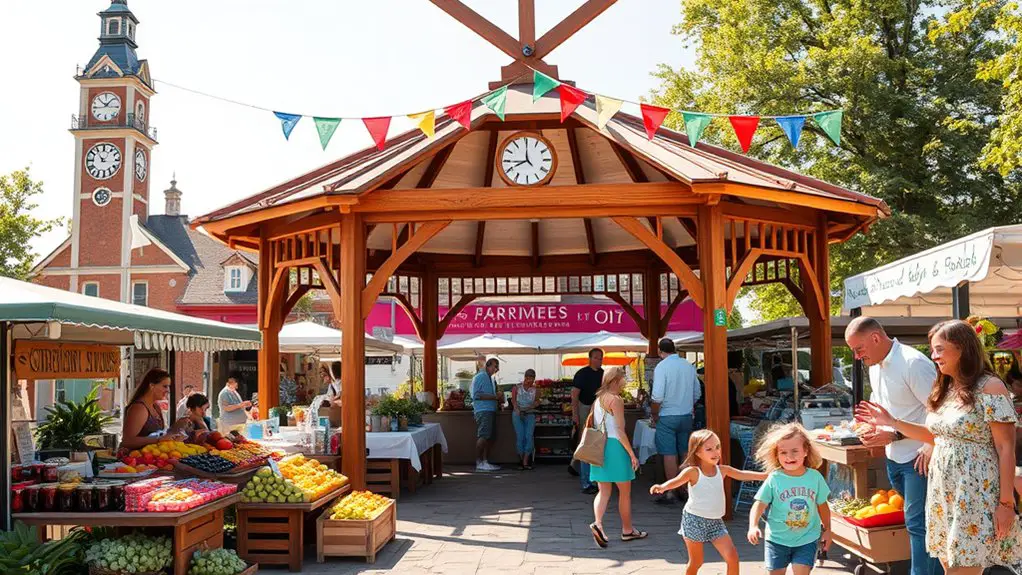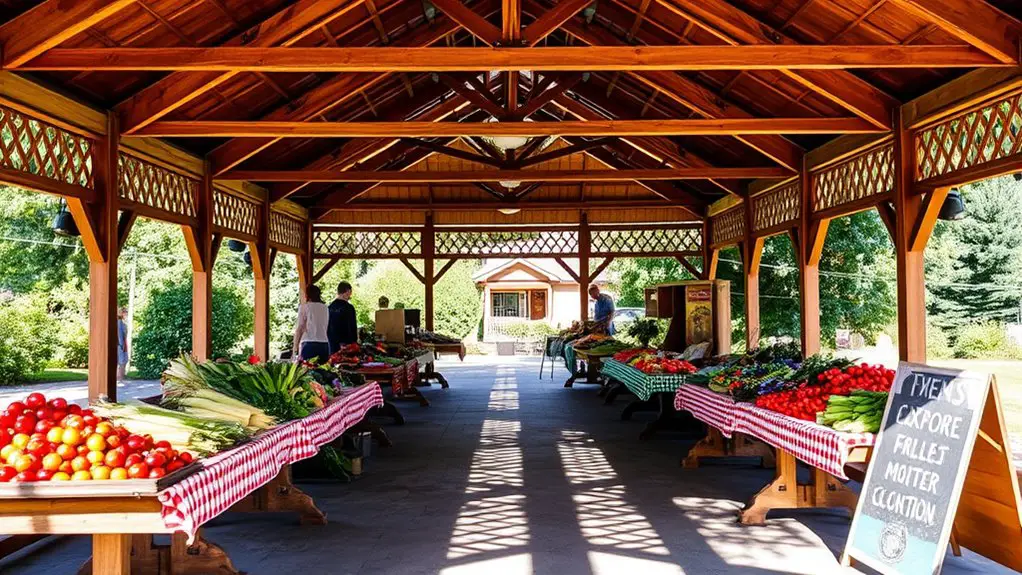Hosting a farmers’ market under your gazebo can be a delightful experience. Start by choosing the perfect date and time, ideally in spring or summer on a sunny weekend. Invite local farmers and artisans to showcase their goods and promote your event through social media. Design a layout that encourages smooth movement and create a welcoming atmosphere with decor and seating. Engage attendees with fun activities and entertainment to foster community connection. Discover more about making your event a success!
Choosing the Right Date and Time for Your Market

When’s the best time to host your farmers’ market? Timing’s essential for maximizing attendance and vendor participation. Start by considering seasonal considerations. Spring and summer months usually yield the freshest produce and a bustling crowd enthusiastic for local goods. Aim for weekends when folks are more relaxed and ready to explore.
Next, keep an eye on weather forecasts. Rain can deter shoppers, while sunny days boost enthusiasm. It’s wise to set your market early in the morning or late afternoon when temperatures are comfortable. You might also think about aligning your event with local festivals or holidays, drawing in more visitors.
Don’t forget to check local school calendars; families often plan outings during breaks. By carefully selecting the right date and time, you’ll create an inviting atmosphere that encourages community engagement and celebrates the freedom found in local, fresh produce.
Inviting Local Farmers and Artisans
Once you’ve settled on the ideal date and time for your farmers’ market, it’s time to focus on inviting local farmers and artisans. Start by reaching out to your community. Craft a warm, informative invitation highlighting the benefits of local partnerships. Emphasize how their participation can strengthen connections and promote sustainability.
Consider hosting artisan showcases to feature unique handmade goods alongside fresh produce. This not only adds variety but also draws in diverse crowds. Be sure to include details about booth sizes, setup times, and any fees involved.
Utilize social media and local bulletin boards to share your vision and attract interest. You can even organize a pre-event meet-up to foster connections among participants and share ideas. Remember, a successful farmers’ market thrives on collaboration, so encourage creativity and community spirit. Your effort to invite local talent can create an unforgettable experience for everyone involved.
Promoting Your Event

To make your farmers’ market event a success, you’ll need to harness the power of social media campaigns and build local partnerships. Consider collaborating with nearby businesses to expand your reach and attract more visitors. Engaging your community online and offline can create buzz and guarantee a lively turnout!
Social Media Campaigns
While you’re planning your farmers’ market event, harnessing the power of social media can greatly amplify your reach. A well-thought-out social media strategy will enhance audience engagement and draw folks in. Create engaging content that showcases your vendors, fresh produce, and activities.
| Platform | Strategy | Example Post |
|---|---|---|
| Event Page | “Join us for a vibrant market day!” | |
| Visual Storytelling | “Check out our colorful veggies!” | |
| Live Updates | “We’re one hour away from opening!” |
Local Partnerships and Collaborations
As you plan your farmers’ market event, forging local partnerships can greatly enhance its success. Collaborating with local businesses, artisans, and community organizations not only boosts your outreach but also creates a sense of unity. Think about reaching out to nearby farms, which can provide fresh produce, or local chefs who might offer cooking demonstrations. This kind of community outreach fosters engagement and draws in diverse crowds. The partnership benefits are two-fold: you promote their products while they help draw attendees to your event. Consider co-hosting workshops or promotional giveaways, leveraging each other’s audience to maximize impact. By building these connections, you’ll create a vibrant atmosphere that encourages community support and celebrates local flavors.
Designing the Layout of Your Gazebo Market
When you’re designing the layout of your gazebo market, it’s essential to contemplate both functionality and aesthetics. Start by optimizing the layout to create an inviting atmosphere where visitors feel free to explore. Place your gazebo centrally to serve as a focal point, providing shade and a gathering spot.
Next, think about traffic flow; guarantee that pathways are wide enough for easy movement. Arrange vendor spaces in a circular or semi-circular pattern around the gazebo, allowing for natural foot traffic and encouraging guests to wander.
Utilize signage to guide attendees and highlight special offerings. Incorporate seating areas to foster community interaction, making visitors more likely to linger and enjoy the market’s vibe. Additionally, providing increased home value can attract more visitors and vendors, enhancing the overall experience of your market.
Lastly, consider accessibility; guarantee that all areas are easily reachable for everyone. With thoughtful layout optimization and an eye for traffic flow, your gazebo market can become a vibrant hub of local culture and connection.
Setting Up Vendor Spaces

To create a successful farmers’ market, setting up vendor spaces effectively is essential for both vendors and customers. Start by understanding vendor requirements; each vendor may need specific allocations based on their products. For instance, a food vendor might require more space than a craft seller.
Plan the layout thoughtfully, considering foot traffic flow and accessibility. Allocate spaces that allow vendors to showcase their goods without feeling cramped, while also inviting customers to browse comfortably. Make sure to communicate clearly with vendors about their designated areas, so everyone understands their boundaries.
Consider creating designated zones for similar products, which can enhance the shopping experience. This promotes a sense of community and encourages customers to explore. By ensuring proper space allocation and adhering to vendor requirements, you’ll set the stage for a vibrant market that benefits everyone involved. Additionally, ensure that the gazebo is positioned in an area that provides sun and shade exposure, as this will enhance the comfort of both vendors and customers. Happy planning!
Creating a Welcoming Atmosphere
After setting up vendor spaces, the next step is crafting an inviting atmosphere that draws customers in and makes them feel welcome. You can achieve this with thoughtful decorative elements and cozy seating arrangements. Imagine vibrant flowers, colorful banners, and handmade signs that reflect the local charm.
Here’s a visual guide to inspire your setup:
| Decorative Elements | Seating Arrangements | Ambiance Enhancements |
|---|---|---|
| Fresh flowers | Benches and chairs | Soft lighting |
| Local artwork | Picnic tables | Music in the background |
| Colorful tablecloths | Lounge areas | Scented candles |
| Seasonal decorations | Communal seating | Outdoor rugs |
| Rustic signage | Cozy nooks | Fire pits |
To further enhance the atmosphere, consider incorporating soft lighting to create a warm ambiance that invites guests to linger.
Incorporating Entertainment and Activities
While a welcoming atmosphere is essential, incorporating entertainment and activities can elevate your farmers’ market event, transforming it into a vibrant community gathering. Consider featuring live music to set the mood; local musicians can create an inviting ambiance that encourages visitors to linger. Choose a variety of genres to appeal to different tastes, making it a fun experience for everyone.
Interactive workshops can also draw in crowds and engage participants. Think about offering sessions like cooking demonstrations, gardening tips, or crafting activities that highlight local produce and crafts. These hands-on experiences foster creativity and allow attendees to learn something new.
Don’t forget about the little ones! Family-friendly activities like face painting or storytelling can keep children entertained while their parents shop. By blending entertainment and activities with your market, you’ll create a lively environment that brings the community together and makes your event memorable.
Encouraging Community Engagement
How can you foster a sense of community at your farmers’ market event? Engaging your neighbors and creating lasting connections is key. Here are some effective ways to encourage community involvement:
- Host community workshops, like cooking demonstrations or gardening tips.
- Set up a “meet your neighbor” booth where attendees can introduce themselves.
- Organize a local talent showcase, allowing musicians or artists to perform.
- Create a feedback corner for visitors to share their thoughts and suggestions.
- Offer fun activities for kids, like face painting or craft stations.
Evaluating the Success of Your Event
To truly measure the success of your farmers’ market event, you’ll want to look closely at attendance and participation metrics. Analyzing sales and revenue can provide valuable insights into what worked and what didn’t. By gathering this data, you can make informed decisions for future events and enhance the experience for everyone involved.
Attendance and Participation Metrics
Evaluating attendance and participation metrics is essential for understanding the success of your Farmers’ Market event. By implementing effective attendance tracking and participation analysis, you can gain valuable insights into your event’s impact. Here are some key metrics to take into account:
- Total visitors: Count the number of attendees throughout the event.
- Demographics: Analyze age, gender, and other factors to tailor future events.
- Vendor engagement: Evaluate how actively vendors interacted with attendees.
- Feedback forms: Gather insights on attendee satisfaction and suggestions.
- Repeat visitors: Track how many guests return for future events.
Sales and Revenue Analysis
Sales and revenue analysis plays a pivotal role in determining the overall success of your Farmers’ Market event. By evaluating sales trends, you can identify which products resonated with attendees and which ones fell flat. Did fresh produce fly off the shelves while artisan crafts lagged behind? Understanding these patterns helps you refine your offerings for future events.
Additionally, accurate revenue projections are essential for budgeting and planning. Calculate your total earnings and compare them against your initial goals. This insight allows you to adjust marketing strategies, vendor selections, and even operational hours for maximum impact. Ultimately, a thorough sales and revenue analysis empowers you to create a thriving market that reflects the desires of your community, enhancing your event’s success.
Frequently Asked Questions
What Permits Do I Need to Host a Farmers’ Market?
Before you plant your market’s seeds, check local regulations and market zoning. You’ll need permits for vendors, food handling, and possibly health guidelines. Cultivating the right documentation guarantees your market flourishes without legal weeds.
How Do I Handle Vendor Fees and Payments?
To handle vendor fees and payments, explore various payment methods like cash or digital options. Establish a clear fee structure, ensuring it’s fair and transparent, allowing vendors the freedom to choose what works best for them.
What Insurance Do I Need for the Event?
For your event, you’ll need liability coverage to protect against potential claims and event insurance to cover unexpected incidents. This guarantees peace of mind, allowing you to focus on creating a memorable experience for everyone involved.
Can I Sell My Own Products at the Market?
Ever dreamed of showcasing your own products? Yes, you can sell! Guarantee your product quality shines, and consider pricing strategies that attract customers. This freedom lets you share your passion while building a community connection.
What if It Rains on Event Day?
If it rains on event day, you’ll need a solid rain plan. Consider offering alternative activities, like indoor workshops or cooking demos, to keep the energy high and guarantee everyone has a great time, no matter the weather.

